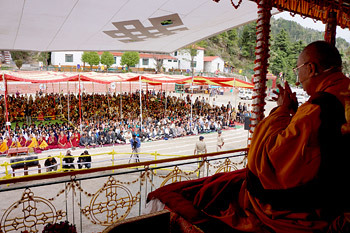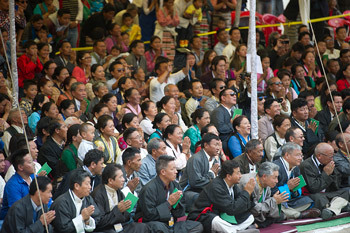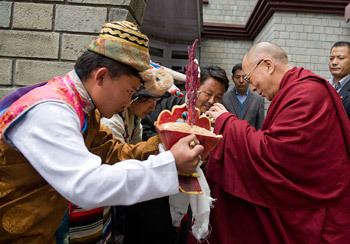Dalhousie, Himachal Pradesh, India, 27 April 2013 - After an early start from Dharamsala, His Holiness the Dalai Lama’s party made exceptionally good time on the drive to Dalhousie. The overcast sky en route was more than made up for by the brilliant purple blossoms of the burgeoning Jacaranda trees along the way. On arrival at the Circuit House in Dalhousie, the former British Hill Station first established in 1854, His Holiness was welcomed by representatives of the local Tibetan and Indian communities.
His Holiness has been invited to Dalhousie to take part in celebrations of the fiftieth anniversary of the Central School for Tibetans (CST) here and after lunch he drove to the school ground above the town. About 2000 people had gathered to listen to him teach. The about 500 Tibetans resident in Dalhousie and 240 students at the school have been joined for this occasion by 577 former students of the school who now live in 10 different countries.
Once His Holiness had taken his seat on the throne, the local settlement officer made the threefold mandala offering and gave a concise report of developments within the school. In his response, His Holiness looked back to its foundation:
“On the occasion of the 50th anniversary here, many current and former students, as well as invited members of the public have come together to celebrate. When we first came out of Tibet we were gathered together in Misamari in Assam where the hot, steamy climate presented a real challenge. During our search for more suitable locations, retired Tibetan soldiers, monks, single men and others gravitated here to Dalhousie. Among them were several great Geshes and practitioners like Trehor Kyorpon and Gyen Nyima Gyeltsen.
“The first head of the CST school was Kundeling Nyima Gyaltsen and he was succeeded by Prof Samdhong Rinpoche, who served for 7 years. Over these five decades the school has produced many illustrious students, who went on to do very well in their lives. And because it is our custom to show our gratitude where it is due, many of them are with us here today.”
His Holiness recalled that while the Central Tibetan Administration requested the Government of India’s help to accommodate monks, former abbots and others, who were gathered in a camp at Buxa in Assam, it focussed on establishing schools, the first of which was begun in Mussoorie and the second in Dalhousie. There was a keen awareness by then that a lack of modern education had not helped Tibet.

|
His Holiness the Dalai Lama speaking during his teaching in Dalhousie, HP, India, on April 27, 2013. Photo/Jeremy Russell/OHHDL
|
“Of course, since then a consensus has begun to grow among educationists and other concerned people that we now need to address a lack of values and ethics in much of our modern education system. Although love, compassion and tolerance are taught in all the major religious traditions, how to deal with our positive and destructive emotions is much less understood. Ancient Indian thought, as translated and preserved in Tibetan literature, has a great deal to contribute to an understanding of this.”
His Holiness went on to say that studying religion is not just a matter of saying prayers; it involves coming to understand what religious teaching means and how to put it into practice. He said that wherever he has the opportunity to teach these days, he tries to begin with some introductory explanation. He said that we all want happiness and do not want suffering, but this is not about whether or not there are future lives, rather it’s about whether we can deal with our emotions. We can change and overcome the difficulties we face, but we need to use reason to do so.
He said that it is important to recognise that we depend on others’ support just to survive. Harmony and peace in society depend on inner peace in the hearts of individuals and to achieve that we need to observe such human values as love and compassion, but not them alone, trust, honesty and transparency too.
Among the world’s religions there are those that are theistic and those that are non-theistic. Among theists, some, Christians and Zoroastrians, for example, do not accept past and future lives, whereas the Indian traditions tend to do so. The non-theistic traditions accept causality, but only Buddhism questions the existence of an unchanging self. Many of our problems arise because we cling to the notion of an autonomous self.

|
Some of the over 2000 people attending His Holiness the Dalai Lama's teachings in Dalhousie, HP, India, on April 27, 2013. Photo/Tenzin Choejor/OHHDL
|
“Within Buddhism there are teachings the Buddha gave openly in public, which include the Four Noble Truths and the Vinaya or monastic discipline. There are teachings that he gave to a select group of disciples, such as the Perfection of Wisdom teachings and there are others, such as tantra, that were given in secret. The first are found in the Theravada countries of Burma, Thailand and Sri Lanka; the second in China, Korea, Japan and Vietnam; but the only in Tibetan Buddhism do we find all three classes of teaching.”
Referring to the establishment of Buddhism in Tibet, His Holiness acknowledged Padmasambhava, but noted that it was the esteemed scholar Shantarakshita who introduced the profound study of philosophy and logic. He said that the essence of Buddhism is the view of dependent arising and non-violent conduct that is consistent with respect for the law of causality. Moreover, dependent arising and non-violence are common to all schools of Buddhism, but to understand and apply them requires reason in addition to faith.
Turning to the text in hand, His Holiness spoke about the author of the Thirty-seven Practices of a Bodhisattva, Gyalsey Thogme Sangpo who lived and taught in 14th century Tibet. The epithet Gyalsey could be taken to refer to a prince, but here implies a son of the Buddhas or a Bodhisattva. He said that he had received an explanation of this text from the Kinnauri Lama, Tenzin Gyaltsen. He then proceeded to read it, stopping to highlight points like the value of a precious human life, the immanence of death, the need to heed the principle of causality and the practice of the six perfections on the path to enlightenment.
At the end he said:
“Always be mindful of what you are doing and concern yourself with the welfare of others. Having listened to this teaching, you have the text, go over it again and try to apply what it says in your own life. You’ll find it will grow within you and you will become calmer, which will be an improvement.”
His Holiness then led the crowd in a ceremony to generate the awakening mind using the well-known verse for taking refuge in the Buddha, Dharma and Sangha and the wish to achieve enlightenment on the basis of the merit of generosity and so forth. He advised:
“We need to cultivate altruism for our own benefit as well as others. But to do that we also need an understanding of wisdom which allows us to appreciate the possibility of achieving liberation. I reflect on the awakening mind of bodhichitta every day and will make every effort to recall it at the time of death; you should try to do that too, then you won’t need anyone else’s help when it comes to time to die.”
His Holiness gave the transmission of several common mantras and concluded with advice to dedicate whatever merit had been created to the benefit of all sentient beings, the flourishing of the Dharma, and the welfare of the people of Tibet.
Tomorrow there will be a formal celebration of the Fiftieth Anniversary of the CST School, Dalhousie.















